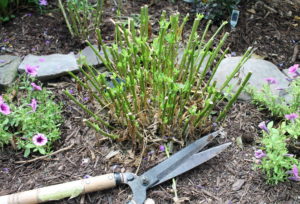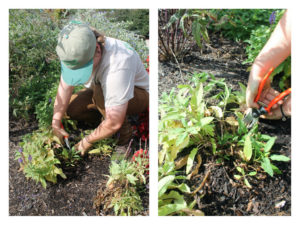Radical Plant-Whacking
July 24th, 2018
I know it sounds counter-productive, but sometimes, whacking a plant almost to the ground during the growing season is the best thing you can do for it.

This formerly mildewed phlox is already starting to grow new leaves after being whacked to a few inches two weeks earlier.
Near-total whack-backs seem like a bad idea, but done at the right time with the right plant, they can lead to better performance – or even saving a plant’s life.
The best example this time of year is cutting back diseased perennials.
Some species are notorious for coming down with fungal infections around the time they’re done blooming.
Peonies often get botrytis blight, lilies-of-the-valley keel over from anthracnose and leaf spot, daylilies suffer from leaf streak, phlox and beebalm usually white out from powdery mildew, and black-eyed susans are increasingly turning all black by mid-summer from septoria leaf spot.
The result is the same – ugly plants that are discolored, collapsing, and generally an eyesore in the July/August garden.
Veteran gardeners know severe cutbacks aren’t death blows (usually). Rather, many plants push up clean, new shoots from the stubs in a matter of weeks.
They usually go on to look fresh and uninfected the rest of the year, and in some cases bloom again by early fall.
Yeah, growing a second set of foliage taps into a plant’s energy reserve. And any wound – intentional or not – costs energy in the sealing and healing of the insult.
On the other hand, dead or dying leaves aren’t doing a plant much good anyway.
Removing them rejuvenates the plants, resulting in new leaves that can absorb sunlight to fuel the re-energizing of the roots.
By getting rid of the diseased leaves and stems, you’re also removing the spores (the fungal equivalent of seeds) that could lead to a new infection.
Give plants a good soaking, a dose of fertilizer, and maybe even a topping of compost after a whack-back, and you’ll boost the recovery.
If disease happens year after year, consider digging and dividing the plant in early spring. Improve the soil with compost before replanting, and you’ll further discourage disease by 1.) adding fresh nutrition, and 2.) improving air flow by giving the divisions more elbow room (18 to 24 inches apart is good).
Cutbacks also occasionally help with chronic bug problems.
A case in point is pachysandra. This 6-inch, evergreen groundcover grows densely, which on one hand is good for choking off weeds, but on the other, good for harboring scale insects and fueling outbreaks of volutella blight.
When either of those problems starts thinning, yellowing, and/or killing pachysandra, gardeners typically reach for a spray or give up and rip out the planting.
A seldom-used option is to whack the whole mass to 2-inch stubs – ideally at the end of winter before new growth begins.
Rake out the rubble, and you’ll remove both scale-egg-infested leaves and blight spores. Plus you’ll be clearing the way for new growth that will have better disease-discouraging air flow. Think of it as a “reboot” instead of having to start over.
Cutbacks aren’t just useful for nursing diseased or bug-infested plants.
Some perennials look better, stay more compact, and/or bloom again even when you cut healthy foliage in early to mid-summer.
Good examples are catmint, salvia, yarrow, spiderwort, and hardy geraniums, all of which get a second wind after decapitation.
Flopping can be prevented in later-blooming perennials by whacking them early in the season. People call it “pinching back” mums, but the technique can be done with sedum, asters, boltonia, Russian sage, and other late-summer or fall floppers. Check out my “Stake No More” post for more on this.
Use hand pruners for small clumps or shears if you have masses of perennials to whack.
Make your cuts down to about 2-inch stubs. Don’t cut flush or lower because then you risk damaging the crown of the plants. The crown is the junction between roots and top growth where new growth emerges.
Healthy foliage can be composted; diseased or bug-infested leaves are best tossed to get the spores and bug eggs out of the yard.
Nervous about turning into Edward Scissorhands? Try this technique with just a few plants at first to see how it goes – especially on plants that you don’t really like that much anyway.
If the worst happens, then at least you have a new opportunity to plant something you like better.








